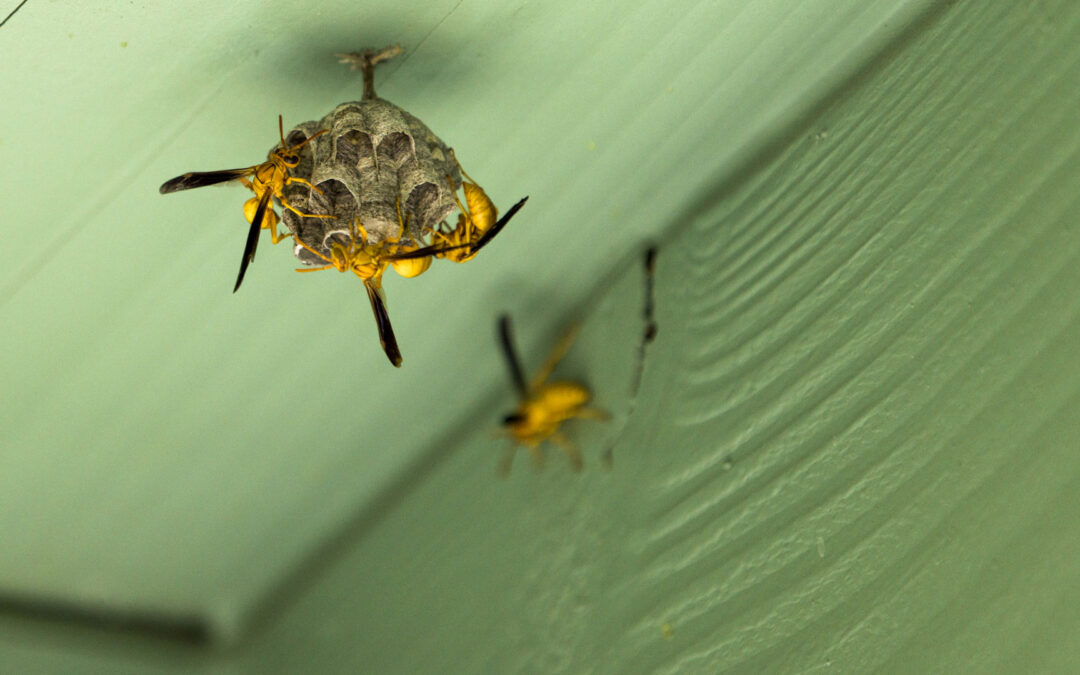August in Maryland signals peak activity for stinging pests like wasps, hornets, and carpenter bees. These insects can be more than just a nuisance—they pose a significant risk to your family’s safety, especially if anyone in your household is allergic to stings. Understanding how to deal with these pests and prevent infestations is crucial during this time of year, as they become more aggressive and active.
The Threat of Wasps and Hornets
Wasps and hornets are two of the most common and aggressive stinging insects in Maryland. Wasps, including species like paper wasps and yellowjackets, are known for their tendency to build nests in and around human structures. Hornets, which are a type of wasp, tend to construct larger, more intimidating nests, often in trees or on buildings.
Why Are Wasps and Hornets More Aggressive in Late Summer?
During late summer, wasp and hornet colonies reach their maximum population size. At this stage, the insects are not only more numerous but also more protective of their nests, leading to increased aggression. Additionally, as natural food sources like nectar dwindle, these insects become more attracted to human food and waste, which brings them into closer contact with people.
DIY Prevention Tips:
- Remove Food Sources: Wasps and hornets are particularly attracted to sugary foods and drinks. Make sure to clean up food and drink spills promptly, especially in outdoor dining areas. Avoid leaving food out in the open, and keep sugary beverages covered.
- Seal Garbage Cans: Outdoor garbage cans can be a major attractant for wasps and hornets. Ensure that your trash bins have tight-fitting lids to keep these pests from scavenging for food.
- Inspect Your Property: Regularly check your property for signs of nests, particularly in high-risk areas like under eaves, in bushes, and around sheds. Early detection is key—removing a small nest is much easier and safer than dealing with a large, established colony.
- Use Wasp Traps: Consider setting up wasp traps around your yard, especially in areas where you and your family spend time. These traps can help reduce the local wasp population and keep them away from your home.
- Dealing with Nests: If you discover a wasp or hornet nest on your property, it’s important to approach with caution. For small nests, it may be possible to remove them safely using over-the-counter wasp sprays, but this should only be done during the evening or early morning when the insects are less active. For larger nests or nests located in difficult-to-reach areas, it’s advisable to contact a professional pest control service like EcoCare Pest Management to handle the situation safely.
Carpenter Bees: Silent Wood Destroyers
Carpenter bees, though less aggressive than wasps and hornets, can cause significant damage to wooden structures on your property. These solitary bees bore into wood to create nesting tunnels, which can weaken wooden beams, decks, and other structures over time. Unlike termites, carpenter bees do not consume wood but excavate it to create nests for their offspring.
Recognizing Carpenter Bee Damage
Carpenter bees prefer untreated or weathered wood and often target eaves, fascia boards, decks, and wooden furniture. The entrance holes they create are typically about half an inch in diameter and perfectly round. Inside the wood, they create long tunnels where they lay their eggs. Over time, repeated tunneling by multiple generations of carpenter bees can cause significant structural damage.
DIY Prevention Tips:
- Treat Exposed Wood: One of the most effective ways to prevent carpenter bee infestations is to treat or paint all exposed wood surfaces. Carpenter bees are less likely to drill into painted or varnished wood.
- Plug Existing Holes: If you notice existing carpenter bee holes, fill them with wood putty or caulk. Once the holes are filled, paint over them to deter future nesting attempts. Be sure to plug holes in the fall, after the bees have left, to avoid trapping any inside.
- Install Carpenter Bee Traps: These traps are designed to attract carpenter bees and capture them before they can cause damage. Place them near areas where you’ve noticed bee activity for best results.
- Dealing with Carpenter Bee Infestations: If you have a significant carpenter bee problem, it may be time to seek professional help. While individual holes can be treated, large-scale infestations can weaken structures and may require more intensive intervention, such as the use of insecticidal dust.
Don’t Let Stinging Pests Ruin Your Summer
August is the time to take proactive steps against wasps, hornets, and carpenter bees. These stinging pests can disrupt outdoor activities, damage your property, and pose health risks, particularly to those who are allergic to stings. By following these prevention tips, you can minimize the risk of an encounter with these pests. However, if stinging pests have taken over your yard or home, it’s best to seek professional assistance to ensure your family’s safety and your property’s integrity.
Protect Your Home from Stinging Pests
If stinging pests have made your outdoor spaces unsafe, it’s time to call in the experts. EcoCare Pest Management provides safe, effective solutions to remove wasps, hornets, and carpenter bees from your property.

